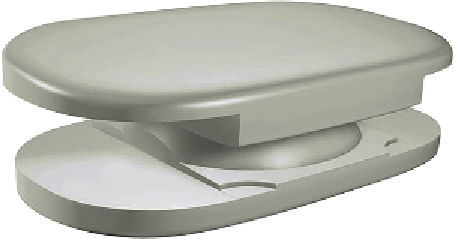Biomedical Engineering Reference
In-Depth Information
Clinical data on the performance of PEEK rods are
currently very limited
[64,67,88]
, both for fusion and
nonfusion applications. A conference poster at
Eurospine in 2009 described a clinical series of
120 lumbar fusion patients, in which 60 patients were
treated with Ti instrumentation and 60 with PEEK
rods
[88]
. Both groups were only followed up for
6 months and generally comparable outcomes were
observed in this preliminary investigation
[88]
.At
present, detailed clinical data for PEEK in these
novel and demanding spinal applications are not yet
available in the peer-reviewed scientific literature and
are
Figure 13.19
PEEK-on-PEEKLumbarNucleusReplace-
ment (NUBAC: Pioneer Surgical Technology).
eagerly anticipated by the
spine
implant
The preclinical mechanical testing for the NUBAC
has been summarized in a review article
[90]
, as well
as in several conference abstracts
[92
e
95]
. The
purpose of this battery of testing was to confirm the
preclinical safety and effectiveness of the lumbar
PEEK-on-PEEK artificial disc. Several wear studies
of the NUBAC artificial disc have been conducted
[93
e
95]
. Initially, the NUBAC was tested for 40
million cycles with unidirectional motion; these tests
generated the lowest amount of wear when later
compared with multidirectional test conditions, but
did not display the marked orientation softening
behavior characteristic of UHMWPE tribology
[94]
.
Researchers also conducted three multidirectional,
10 million cycle tests in accordance with ISO/DIS
18192-1, in which the loading was adjusted to
account for the load sharing between the annulus and
the nucleus in the lumbar spine. In one series of tests,
the components were gamma irradiated in air with
200 kGy and accelerated aged in accordance with
ASTM F2003 for 40 days
[93,94]
. ASTM F2003 was
developed for gamma-irradiated UHMWPE, but as
explained in Chapter 6, the protocol is conducted at
70
C and is too low to influence PEEK. Regardless
of the testing protocol, and including the standard-
ized UHMWPE oxidative challenge, the average
wear rates for the NUBAC experiments were rela-
tively insensitive to changes in testing parameters,
and fell within the range of 0.4
e
1.0 mm
3
per million
cycles
[94]
. Overall, the wear values for the NUBAC
were judged by the authors to be comparable with the
rates for other metal-on-metal and metal-on-polymer
artificial discs
[101
e
103]
.
An international multicenter prospective clinical
trial of the NUBAC is currently under way. At the
2009 meeting of the Spine Arthroplasty Society, it
was announced that 225 NUBAC devices had been
implanted since December 2004
[91]
. The authors
community.
13.8 Cervical and Lumbar Artificial
Discs
All-polymer artificial discs fabricated from PEEK
biomaterials have attracted growing interest from the
research community as a second-generation alterna-
tive to contemporary TDRs, which are now most
often fabricated from UHMWPE and CoCr alloys.
Polymer bearings are considered promising for arti-
ficial discs due to a favorable combination of
mechanical strength, wear resistance, radiolucency,
biocompatibility, and manufacturability that is
unique to the family of PEEK biomaterials
[89,90]
.
Initial investigations of all-polymer PEEK bearings
were performed for the lumbar spine
[90
e
96]
,but
recently the focus of scientific and commercial
inquiry has shifted to cervical spine applications
[89,97,98]
, which experience lower loads and are
biomechanically less demanding. Mirroring the
increased interest in all-polymer disc arthroplasty
bearings, several basic science, pin-on-disc research
studies of PEEK-on-PEEK articulations have also
recently been completed
[99,100]
and are summa-
rized in Chapter 16. In this section, we review the
latest advances in all-polymer PEEK bearings for
disc arthroplasty.
The first artificial disc fabricated entirely from
unfilled, PEEK-OPTIMA LT1 was the NUBAC
intradiscal arthroplasty device for the lumbar spine
(Pioneer Surgical Technology, Marquette, MI)
[90
e
96]
. The design consists of a semiconstrained
ball-and-socket joint and is intended to serve as an
intradiscal, load-sharing device, analogous to
a nucleus replacement (
Fig. 13.19
), with an intact and
a competent annulus fibrosus.

